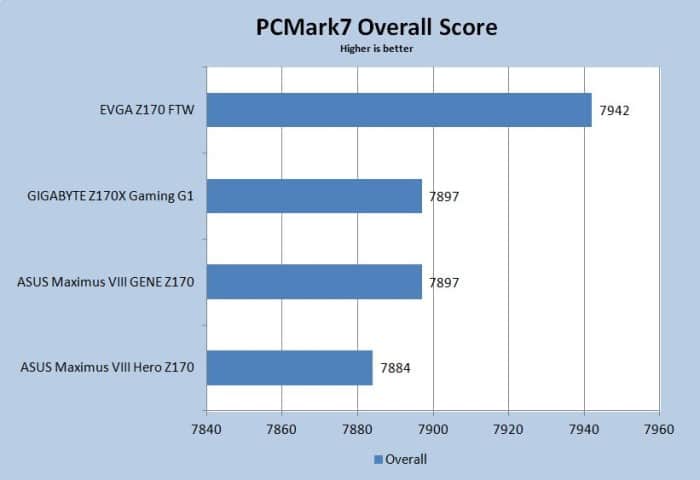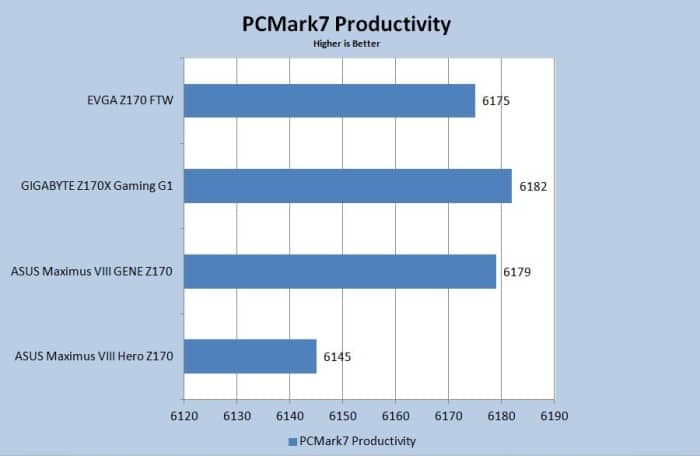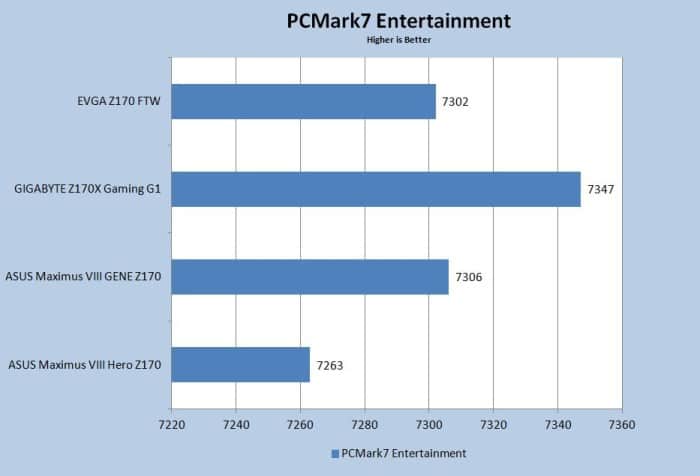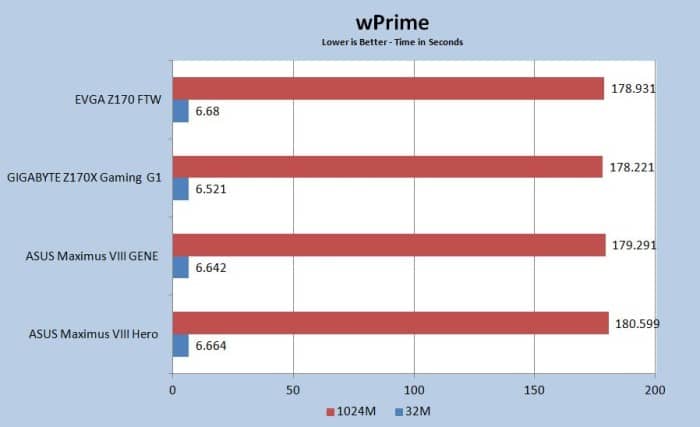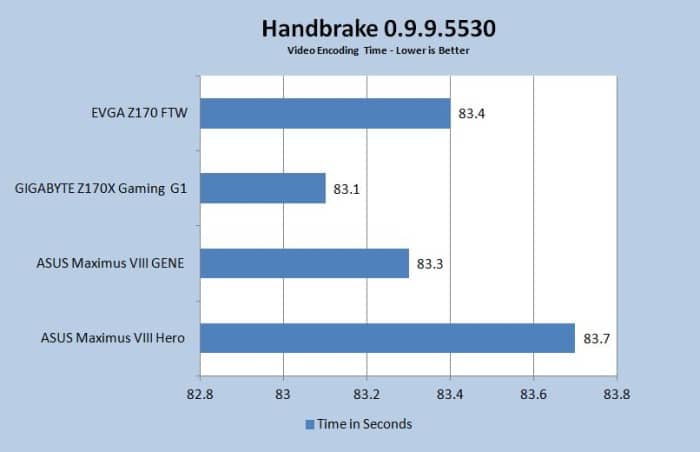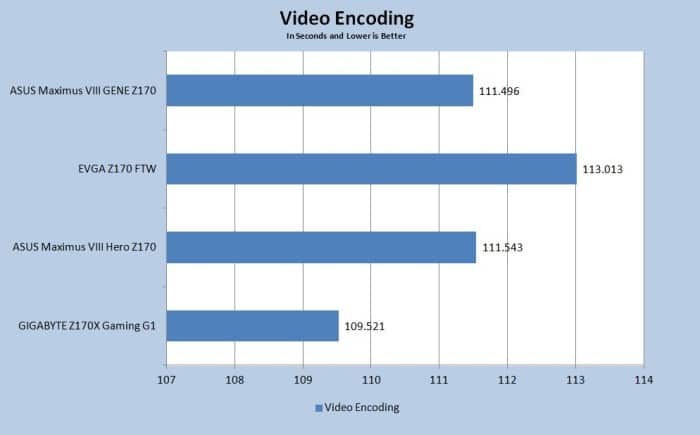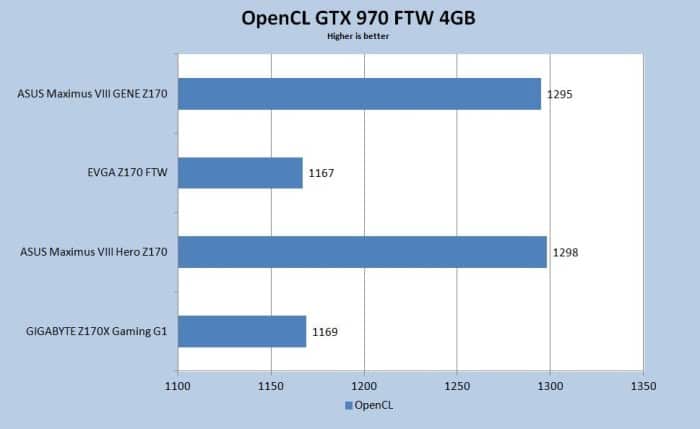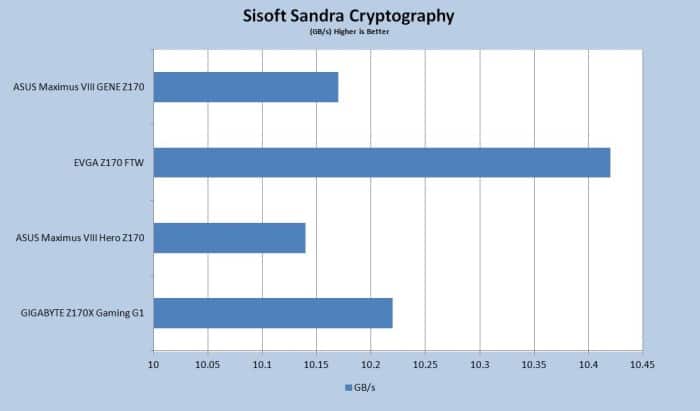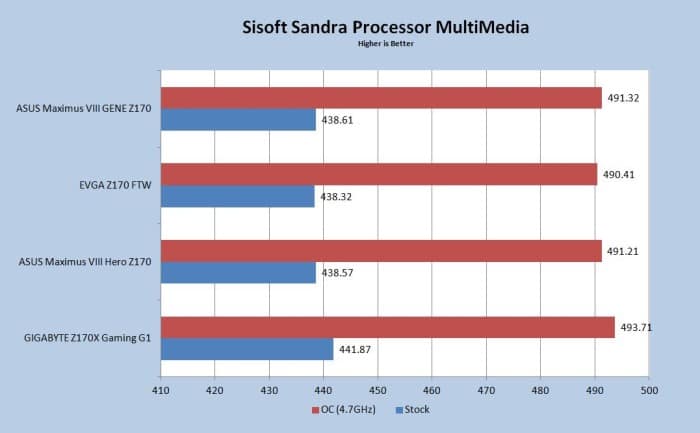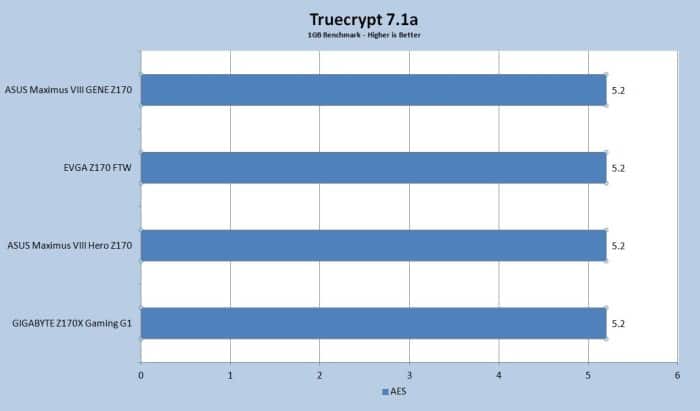Benchmarking
PCMark 7 is a complete PC benchmarking solution for Windows. It includes 7 tests combining more than 25 individual workloads covering storage, computation, image and video manipulation, web browsing and gaming. Specifically designed for the full range of PC hardware from tablets to notebooks and desktops, PCMark 7 offers complete Windows PC performance testing for home and business use.
We started with the creativity benchmark first for the Z170 chipset that is built by Intel. Most boards will generate similar performance. Minuscule differences in benchmarks do occur and can be impacted by numerous variables down to hardware, cooling system and even temperature of the room. We typically allow for – or + 4% margin for testing variables and this board we feel falls within this margin. The ASUS ROG Maximus VIII GENE gave us a 11783 which is a pretty good score considering that the small differences in the three averaged benchmark runs can account for the differences from top spot to bottom spot on the PCMark7 Creativity test.
We find another great example showing just how minuscule the differences can be between boards, with the Maximus VIII we tested tying with the GIGABYTE board in this test. If you are a skilled overclocker and know your way around settings like a pro we are sure that you could improve the score and even surpass the results we got for the EVGA board. Here at Bjorn3d we tune and OC to run a quick 1m SuperPi Mod and a WPrime run for testing. The one test measures one core performance and memory tuning; the other tests all the cores and is affected by memory performance. The same CPU speed of 4.0 – 4.2GHz is used in all testing. We also OC the 2800MHz Ram kit is running at 3000MHz. Here at Bjorn3D we like to carefully control the hardware and tuning produces similar results and is a product of stringent reproducible benchmark conditions to provide a level and fair testing process.
We achieved a solid score of 6179. The highest scored board tested at 6182 and for testing purposes this is well within the acceptable margin so for all purposes these are the same.
In the Entertainment Test, the ASUS Maximus VIII GENE turns in a 7306 and there’s less than a hundred points variance, which is a acceptable margin. The consolidation of features that were formally external to the Intel chipset that are now built into the chips was pretty inevitable and has brought a booming age of excellent overclocking and reliable performance. We find that features are often differentiating factor in choosing a board these days.
Super PI Mod 1.5
Super PI is a single-threaded benchmark that calculates Pi to a specific number of digits. It uses the Gauss-Legendre algorithm and is a Windows port type of program used by Yasumasa Kanada in 1995 to compute Pi to 232 digits.
The SuperPi Mod 1.5 8M shows the ASUS Maximus VIII GENE only .036 seconds behind the Flagship EVGA Z170 FTW board.
Looking at the SuperPi 1M run we achieved a 7.694 second run with about .095 seconds variance between the EVGA Z170 FTW leader in this test.
wPrime
wPrime is a leading multithreaded benchmark for x86 processors that tests your processor performance by calculating square roots with a recursive call of Newton’s method for estimating functions, with f(x)=x2-k, where k is the number we’re sorting, until Sgn(f(x)/f'(x)) does not equal that of the previous iteration, starting with an estimation of k/2. It then uses an iterative calling of the estimation method a set amount of times to increase the accuracy of the results. It then confirms that n(k)2=k to ensure the calculation was correct. It repeats this for all numbers from 1 to the requested maximum.
Keep in mind that SuperPi is focused on single core testing run figures PI to X places, Whereas WPrime is a fully threaded application that you can set from 1 thread to all threads. We run it with every core and every thread so we can see how well the motherboard operates when the CPU is using every thread that is required to cooperate in calculations. In this test we are seeing 1.07 seconds variation behind the chart leader on the 1024M test and less than a second behind in the 32M test.
CINEBENCH R15
CINEBENCH is a real-world cross-platform test suite that evaluates your computer’s performance capabilities. CINEBENCH is based on MAXON’s award-winning animation software CINEMA 4D, which is used extensively by studios and production houses worldwide for 3D content creation. MAXON software has been used in blockbuster movies such as Iron Man 3, Oblivion, Life of Pi or Prometheus and many more.
The CineBench is a graphic animation software and as such focuses on rendering animations to test your computer’s Multi-Core capabilities and throws OpenCL testing is as well. CineBench preferred the EVGA Z170 FTW enough to put it on top the chart but then again we are also looking at minute differences in the grand scheme of things. One trap most reviewers run into is changing system parts and expecting similar scores, when something as small as changing from one model of graphics card in the same family to another, changing hard drives or memory will change the outcome of the test and affect your score. With the test system we use we try to use the same components with minor exceptions to produce the most reliable numbers in order to rule out hardware variables.
x264 HD
Simply put, x264 HD Benchmark is a reproducible measure of how fast your machine can encode a short HD quality video clip into a high quality x264 video file. It’s nice because everyone running it will use the same video clip and software.
The X264HD test shows the ASUS Maximus VIII GENE leading the Hero board on 2 pass with .16FPS margin and on one pass .2 separates it from the rival ASUS Maximus VIII Hero. The margin is small enough that the minuscule differences in this test show just how good the boards actually are and all the boards perform excellently. Often the small benchmark differences are a more or less mature BIOS and within a reasonable margin of testing error. Features and Price / Performance ratios differentiate motherboards, and in other cases OCing ability plays into the user requirements. The Uber and often excessive high-end boards with 75 phase power will generally produce more stable OC for LN2 users. Usually it is the high-end features and amenities that we look for that blow us away and garnish our hearts.
Unigine Heaven 4.0
The Heaven Benchmark, in its current version 4.0, is a GPU-intensive benchmark that pushes and stresses graphics cards to the limits. This powerful tool can be effectively used to determine the stability of a GPU under extremely stressful conditions, as well as check the cooling system’s potential under maximum heat output. It provides completely unbiased results and generates true in-game rendering workloads across all platforms.
For a long time Unigine Heaven 4.0 has been used as a trusted measure of performance using a real life gaming engine that pushes and stresses GPUs as well as providing a sense of how well the system handles graphics cards and all the individual subsystems that support them. The EVGA FTW board is a great design but we think the simplicity and solid circuitry on the board gives it a little advantage here. Sometimes complex circuitry like what is found in high-end boards can cause a little latency and result in small differences in the scores. For instance, the Maximus VIII GENE came in a minuscule 8 points below the chart topper and 1.83 FPS slower but these minor performance variations are a small difference that is more than likely attributable to minor variations in hardware, software and temperature.
Handbrake
We used a 900K Big Buck Bunny video and trans-coded it from AVI to MP4 three times, we added up those 3 runs and averaged the scores reported here.
Here is a detailed breakdown of HandBrake’s features:
Built-in Device Presets—Get started with HandBrake in seconds by choosing a profile optimized for your device, or choose a universal profile for standard or high quality conversions. Simple, easy, fast. For those that want more choice, tweak many basic and advanced options to improve your encodes.
- Supported Input Sources—Handbrake can process most common multimedia files and any DVD or Blu-ray sources that do not contain any kind of copy protection.
- Outputs:
- File Containers—MP4 and MKV
- Video Encoders—H.264 (x264), MPEG-4 and MPEG-2 (libav), and Theora (libtheora)
- Audio Encoders—AAC, CoreAudio AAC/HE-AAC (OS X Only), MP3, Flac, AC3, or Vorbis/li>
- Audio Pass-thru—AC-3, DTS, DTS-HD, AAC and MP3 tracks
- Additional features:
- Title/ Chapter Selection
- Queue up Multiple Encodes
- Chapter Markers
- Subtitles (VobSub, Closed Captions CEA-608, SSA, SRT)
- Constant Quality or Average BitRate Video Encoding
- Support for VFR, CFR and VFR
- Video Filters—Deinterlacing, Decomb, Detelecine, Deblock, Grayscale, Cropping and Scaling
- Live Video Preview
ROG RealBench
RealBench uses real and open source application tests that your PC would perform in real life. Although it can be competitive, it’s not primarily designed to be more hardcore and time-consuming – it’s a benchmark for everyone that was developed by ASUS ROG division.
You select the four tests that are shown on the side and run the benchmark to get your score. Each test focuses on different parts of your PC and the different hardware, so all aspects are covered. You can even share the results on the ROG forum that allows the user to compare their system to others and get ideas on OC and hardware to get maximum value from the PC you have or are building.
RealBench is a benchmark tool that we have been using since its creation. It is an open source software that does not favor any specific manufacturer as you can see by the results. It scales extremely well with every component we test it on. When you select the benchmarks that you would like to test for (we leave all of them to run), then click “Start” and if you so much as move the mouse or hit a key, the test stops. No human interference is allowed and as such is a reviewer’s dream. Personally we find unplugging the keyboard and mouse will prevent this from occurring.
Heavy Multitasking pushes all the cores extremely hard and puts stress on them. The ASUS Maximus VIII GENE Z170 scores a 97.733 and places second on this chart. All the boards are extremely tightly grouped in this test.
In our test we achieved a 74.122 second run on the Image editing test, However the small margin of spread between the boards in this chart could be attributed to voltage fluctuations, ambient room temperature or some other small variable.
The ASUS Maximus VIII GENE board performed this test extremely well and was within margin of its bigger cousin the Hero. The scores overall were very close and something that only a few years ago would have seemed unattainable by mere mortals.
In this test we nearly tied its big brother the Hero and tested pretty close to the other boards. The difference here is small in the grand scheme of things and could be fixed with a change of hardware.
SiSoft Sandra
The SiSoft Sandra software was designed as a complex utility for analyzing your computer’s software and hardware capabilities as well as running various tests to put high amounts of stress on the individual components. The software has numerous options that can require significant time to get used to if you’re not familiarized with this software.
When it comes to hardware, it is hard to get a complete overview on the computer (e.g. processors, memory, graphics), storage adapters and devices (e.g. drive geometry, S.M.A.R.T.), motherboard, chipsets, busses, processors, power management, display and video adapters, GP (General Purpose) processors and accelerators and various subcomponents.
There are several types of benchmarks available with this software, such as SIMD processor units, ALU and FPU processors, as well as financial analysis. Any specific tasks that you frequently perform can be added to a favorites list for quick access. Information from any or multiple tests can be exported to a number of different file types for further analysis. Tests that you don’t require can be easily removed/deselected. It is also possible to monitor and use the reports to evaluate the condition and health of your system.
The field of cryptography is a common theme in computing, usually with a more sinister reason since most data breaches involve cryptography. The ASUS Maximus VIII GENE posted 10.17 GB/s, which is not too far behind the EVGA board.
The new SkyLake chip and the Z170 chipset is the first consumer grade chip to run Dual Channel DDR4 and all the boards we have tested default at 2666MHz that we OC to 3000MHz. While the ASUS Maximus VIII GENE is kind of in the middle, the variation that we see is so tiny that we cannot really speculate.
Using the Patriot Viper 4 memory kit, we can see the differences were – and + a few nanoseconds. With additional tweaking of the memory, any user could change the outcome of such a test on any board.
The ASUS Maximus VIII GENE scored nearly identical to all of the other boards we have tested, so much so that this similarity could be attributed to external non hardware aspects.
In the Sisoft Sandra Multimedia test and in this test, we decided to show you stock and OC performance results on the boards. All the boards hit 4.7GHz with some effort but to get the best performance out of each board we spent several hours in order to achieve a stable setup. While some similarities might exist, minor settings might need to be changed.
TrueCrypt
TrueCrypt is a discontinued source-available freeware utility used for on-the-fly encryption (OTFE). It can create a virtual encrypted disk within a file or encrypt a partition or (under Microsoft Windows except Windows 8 with GPT) the entire storage device (pre-boot authentication).
This is one benchmark that didn’t really provide us any results that separated the ASUS Maximus VIII GENE board from any of the others. Even when OC the CPU it provided a small .6GB increase in the decryption. All boards showed similar results so this test does little to show any differentiation between the boards performance wise.
Metro 2033
In 2033, a nuclear war occurred, forcing a large amount of Moscow’s surviving population to relocate to underground metro stations in search of refuge from the outside world. Eventually, those who settled in the underground train stations evolved their homes into independent station-countries. Soon, new factions grew, ranging from the independent “Rangers” to the communist “Red Line” faction to the “Fourth Reich” which constantly engages in skirmishes with the former group. As these small states began to evolve, the Red Line and the Fourth Reich entered a permanent state of war, as both sought to control the metro and its resources. As the war raged, those stations who refused to join either side were massacred by the militants, raided by bandits, or outright destroyed by the Dark Ones – paranormal, otherworldly, mutated humans who live on the ravaged surface. While most of the stations are controlled by the three factions, several stations are abandoned, some have independent tribal rule, while some are occupied by the Dark Ones. Within one of those stations is where the events of Metro 2033 unfold.
In the Metro 2033 we see the ASUS Maximus VIII GENE scoring 67.6 FPS Average FPS using a GTX 970 FTW 4G. As you can see all of the boards perform very well with using the GTX 970 FTW 4G. Now we could use a GTX 980 Ti and you would see a much higher result. However the GTX 970 FTW 4G is a good card that is affordable to the masses. Since this is a board review, we see no point in using a big fancy card, but we would rather focus on the board.
 Bjorn3D.com Bjorn3d.com – Satisfying Your Daily Tech Cravings Since 1996
Bjorn3D.com Bjorn3d.com – Satisfying Your Daily Tech Cravings Since 1996


